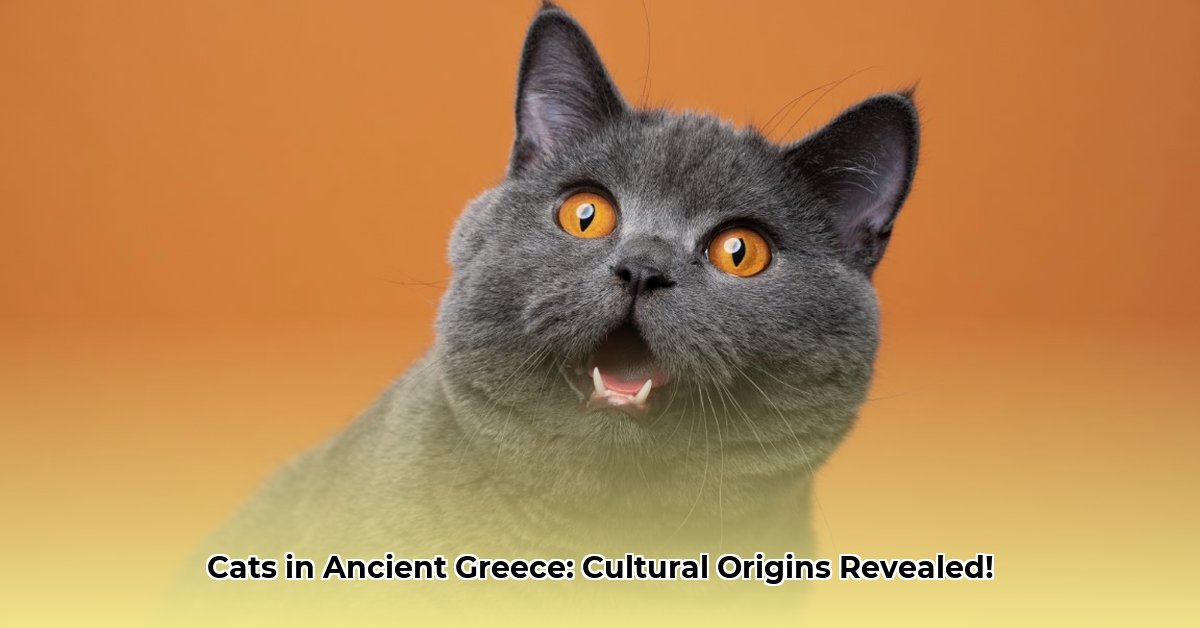Imagine ancient Greece, a civilization renowned for its philosophical prowess, heroic sagas, and intricate pantheon of gods. Within this grand narrative, a quieter, more subtle story unfolds—that of the cat. These creatures did not arrive with the fanfare of conquering heroes or the solemnity of divine emissaries. Instead, they likely sneaked ashore, silent stowaways on creaking merchant ships from the sun-drenched lands of Egypt. Their emerald eyes, wide with a quiet curiosity, surveyed the bustling docks of Piraeus, marking their clandestine entry into a civilization that would, in time, subtly embrace them. Learn more about animals of Greece that roamed at this time.
Initially, their role was purely pragmatic. The Greeks, ever practical, quickly recognized the exceptional utility of these agile hunters. Picture a sun-drenched courtyard, where valuable grain stores, vital to the ancient economy, were under constant threat from scampering rodents. The cat, with its silent tread and uncanny predatory instinct, offered a natural, living solution. Yet, even in this utilitarian capacity, a hint of something more began to emerge. An independence in their gaze, a self-possessed grace, perhaps resonated with the very spirit of the Greeks themselves, signaling a path from mere helper to something woven into the cultural fabric. This is the nuanced tale of how these enigmatic felines found their place, transitioning from simple pest controllers to symbols reflecting independence and even a touch of the divine.
Cats in Ancient Greece: A Gradual Adoption
The story of cats in ancient Greece isn’t one of immediate adoration or widespread veneration like in their native Egypt. Instead, their tale is a quiet journey, a slow and steady waltz into the bustling homes and practical considerations of the ancient Greeks. It’s a compelling narrative of how a practical solution to a pervasive problem blossomed into a nuanced appreciation for these inherently independent creatures, shaping their enduring presence in Western culture.
From Nile to Aegean: Early Feline Footprints
While the exact history of human interaction with cats is still somewhat vague, archaeological evidence suggests a very early connection. A shallow grave site discovered in 1983 in Cyprus, dating to 7500 BCE during the Neolithic period, contained the skeleton of a human, buried ceremonially, alongside an eight-month-old cat in its own tiny grave nearby. Cats are not native to Cyprus, suggesting they were being tamed as humankind established the first settlements in the Fertile Crescent. This predates the famed Egyptian veneration by millennia.
For Greece, the introduction of domestic cats was much later, likely occurring in the fifth century BCE, primarily through the seafaring Phoenicians who facilitated trade across the Mediterranean. These early feline arrivals were not met with the immediate reverence seen in Egypt, where cats like the mau were associated with goddesses such as Isis and Bastet and mummified with respect. Instead, in Greece, the situation was markedly different.
Consider the vibrant harbors of ancient Greece, where merchant ships, laden with goods, bobbed gently. Among the precious cargo, nestled amongst sacks of grain from fertile foreign lands, were a few unexpected passengers: cats. These felines, drawn by the promise of abundant food, were not invited guests but rather resourceful stowaways, likely padding off those very ships into the dynamic world of ancient Greece. Their journey from the Nile Delta to the Hellenic peninsula was a quiet migration, yet it planted the seeds for a significant integration into society.
Their initial role was unequivocally practical. Imagine the sun-drenched courtyards and granaries overflowing with precious wheat – prime targets for mice and other rodents that threatened vital food supplies. The Greeks, known for their resourcefulness, swiftly recognized the immense value these agile hunters offered. Cats quickly became natural pest control specialists, silently patrolling food stores and keeping the rodent population at bay with remarkable efficiency.
Linguistic Ambiguity and the Weasel’s Reign
Interestingly, the Greeks had a primary rodent-killer before cats gained widespread acceptance: the weasel. As late as the second century AD, weasels were still regarded as superior mousers by some. The Greek historian Herodotus, even in the fifth century BCE, expressed astonishment at the domestic cats he encountered in Egypt, implying their rarity in Greece at the time. This contrast highlights that cats were not an immediate, obvious choice for rodent control in Greece.
Moreover, the ancient Greeks often used the same word, ailouros (meaning “thing with the waving tail”), to refer to both cats and various mustelids (like weasels or ferrets). Another term, galéē, primarily applied to weasels, could also sometimes refer to cats. This linguistic ambiguity underscores how closely linked these animals were in the Greek mind, suggesting that a clear distinction wasn’t always made, or that their roles overlapped significantly.
Despite this initial preference for weasels, evidence of cats’ gradual acceptance emerged. The earliest unmistakable evidence of Greeks keeping domestic cats comes from two coins from Magna Graecia (southern Italy), dating to the mid-fifth century BC. These coins show Iokastos and Phalanthos, the legendary founders of Rhegion and Taras respectively, playing with their pet cats. Further evidence includes relief carvings on Athenian funerary monuments from around 440 BCE and 420 BCE, which depict the deceased with cats, strongly suggesting they were cherished pets. Even the philosopher Aristotle, in his History of Animals (4th century BCE), observed feline behavior, noting that “female cats are naturally lecherous,” indicating they were a familiar, if not ubiquitous, sight. This illustrates a slow but steady integration into Greek households.
A Reflection of the Greek Spirit: Sophrosyne and Xenia
In ancient Egypt, felines were revered, often seen as sacred beings and even embodiments of deities like Bastet. But did the Greeks, with their emphasis on logic and balanced living, perceive them differently? The relationship in Greece seems to have been distinct, yet equally profound in its own way. The Greeks, renowned for their pursuit of sophrosyne (self-control, moderation, and a balanced approach to life), may have seen qualities in cats that resonated deeply with their own ideals. Cats, with their serene demeanor and quiet self-assuredness, seemed to embody these very principles. Could it be that the Greeks saw in the independent spirit of these creatures a subtle reflection of their own cherished values? It is a compelling thought, suggesting that the integration of cats was not just practical but also subtly philosophical.
There’s also the concept of xenia, the sacred bond of hospitality between guest and host, which was fundamental to ancient Greek society. While cats weren’t “guests” in the conventional sense, their capacity to integrate into households, forming a comfortable, albeit independent, companionship with their human counterparts, likely allowed them to benefit from this deeply ingrained cultural value. Even if primarily valued for their pest control abilities, the Greek emphasis on hospitality probably ensured they were well-treated and tolerated within the home, evolving from mere tools to household companions. By the Hellenistic Period (c. 323 – c. 31 BC), keeping cats as pets seems to have gradually become more common.
Cats in Greek Mythology and Art: Subtle Symbolism
While cats were never central figures in the pantheon of Greek mythology, their characteristics subtly influenced depictions and associations with certain goddesses. Their appearances in Greek art also grew, reflecting their evolving role in society.
Mythological Whispers and Divine Connections
Unlike the outright deification of cats in Egypt, Greek deities were not typically depicted as feline-headed. However, cats did find themselves subtly linked to certain Greek goddesses. Artemis, the formidable goddess of the hunt, wilderness, and childbirth, embodied traits strikingly similar to feline characteristics: the fierce protectiveness, the silent stealth, the untamed spirit. Ovid’s Metamorphoses even tells a story where Diana (the Roman equivalent of Artemis) transforms into a cat when the gods flee to Egypt and take animal forms.
Hecate, the enigmatic goddess of magic, witchcraft, and crossroads, also became strongly associated with cats, particularly black cats, during the Hellenistic period as Egyptian influences broadened. According to legend, Hecate transformed into a black cat to assist witches in summoning a demon, leading to the belief that black cats became her sacred animal, bringing good luck and protection from evil spirits, despite later medieval superstitions linking them to misfortune.
The intriguing story of Galinthias also links cats to Greek mythology. Galinthias, a handmaiden to Alcmene, was transformed into a cat by Hera as punishment for interfering with the birth of Heracles. Despite her transformation, Galinthias remained fiercely loyal to Alcmene and became known as the “witch’s cat,” aiding witches in their magical work. These myths suggest that cats were transcending their role as mere rodent catchers; they were becoming linked to the mystical and the mysterious, gaining a symbolic weight beyond their practical skills.
Feline Depictions in Greek Art
Cats carved a curious niche in ancient Greek life, a story subtly told through their infrequent yet significant appearances in art depictions. Early evidence suggests their presence, yet their true societal integration occurred gradually. Initially prized for their proven ability in pest control, they diligently guarded precious food stores from pesky rodents, thereby earning their practical place in homes, granaries, and vital warehouses. How valuable were these silent guardians to a society dependent on its harvest?
Over time, these agile creatures transformed from mere workers to subtle symbols of grace and independence. How did this happen? Greek art began to reflect this nuanced shift, with felines appearing on pottery and sculptures. One of the most famous examples from the Roman Period (c. 1st century CE) is a fabulous mosaic from the House of the Faun in Pompeii depicting a housecat killing a partridge, showing their continued hunting prowess and domestic presence. Though cats were rare in earlier Greek art compared to dogs or horses, they did appear on coins from cities like Rhegion and Taras depicting legendary founders with cats, and on funerary steles, suggesting an emerging role as beloved companions. Often shown as skilled hunters or elegantly poised companions, these images signaled a growing appreciation for their inherent beauty and remarkable agility, which resonated with the Greek aesthetic.
Lasting Paw Prints: From Antiquity to Modern Greece
The Greek experience with felines undeniably had a ripple effect on subsequent civilizations, especially the Romans. The Romans adopted cats not only for their well-established ability to control pests but also, significantly, for their companionship. This burgeoning affection for cats spread throughout the Roman Empire, eventually influencing much of Europe and laying groundwork for the widespread appreciation of felines that we see today across Western cultures. Cats eventually displaced ferrets as the pest control of choice because they were more pleasant to have around the house and were more enthusiastic hunters of mice.
In modern-day Greece, cats continue to hold a special place. Many Greek islands, such as Mykonos and Santorini, are renowned for their abundant and friendly cat populations, making them popular cat-friendly tourist destinations. Locals often care for stray cats, leaving out food and water, highlighting a deep-seated cultural affection that extends back through historical layers. This enduring presence, from ancient granaries to modern courtyards, underscores the profound and lasting impact of these captivating creatures.
Did the subtle beginnings of cat appreciation in ancient Greece unknowingly spark the global love affair with felines? It is certainly plausible. While cats may not have commanded front-page attention in the ancient Greek polis, their journey from humble stowaways to valued members of society is an intriguing and often overlooked chapter of history. It serves as a potent reminder that even the smallest creatures can leave a lasting paw print on the grand tapestry of human civilization, shaping our views toward these mysterious and captivating household companions even today.
| Feature | Ancient Greece | Ancient Egypt |
|---|---|---|
| Primary Role | Pest control; gradual shift to household companions | Religious significance; veneration; divine symbol |
| Cultural Value | Embodiment of sophrosyne, xenia, independence | Sacred animal; divine embodiment; protection |
| Artistic Depiction | Less frequent, often subtle; later more common | Highly frequent and prominent; often deified |
| Overall Impact | Influenced Roman adoption of cats; subtle cultural integration | Direct worship and protection; deep societal integration |
Core Insights on Cats in Ancient Greece
The journey of cats in ancient Greece reveals a fascinating evolution in their societal role and cultural symbolism:
- Initial Utilitarian Introduction & Weasel Rivalry: Cats first arrived in Greece, largely from Egypt via maritime trade, serving primarily as effective agents for pest control in homes and vital granaries. Their acceptance was initially slow, challenged by the traditional role of weasels, a nuance reflected in shared linguistic terms like ailouros and galée.
- Cultural Integration and Value Reflection: Over centuries, their perception broadened beyond mere utility. Their independent nature and grace resonated with core Greek values like sophrosyne (self-control) and xenia (hospitality), leading to their gradual acceptance as household companions evident in archaeological finds like coins and funerary steles.
- Mythological and Lingering Influence: Cats gained symbolic weight, appearing in Greek mythology in association with goddesses like Artemis and Hecate (and even the cautionary tale of Galinthias), a shift influenced by broader Mediterranean cultural exchanges, including burgeoning Roman affection. This subtle integration solidified their place, impacting Western cultures‘ perception of felines even to this day.
- Unearth ancient rome roads: Empire’s power and modern highway’s origin - August 15, 2025
- Discover geography of ancient Rome: Empire’s secrets revealed (2024 insights) - August 15, 2025
- Unveiling Ancient Roman Empire Geography: Power & Legacy Secrets - August 15, 2025
















